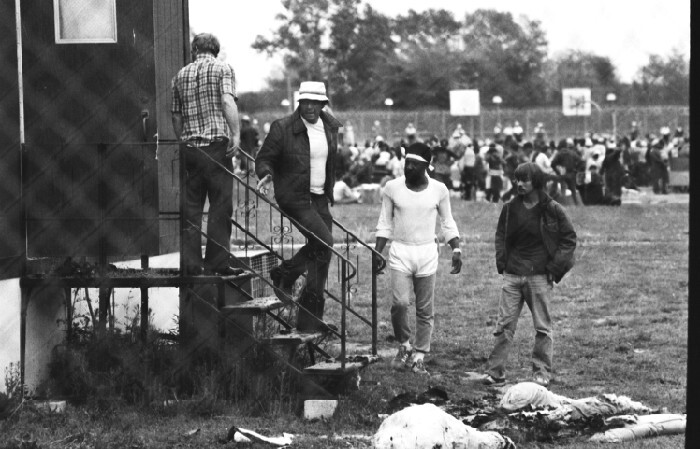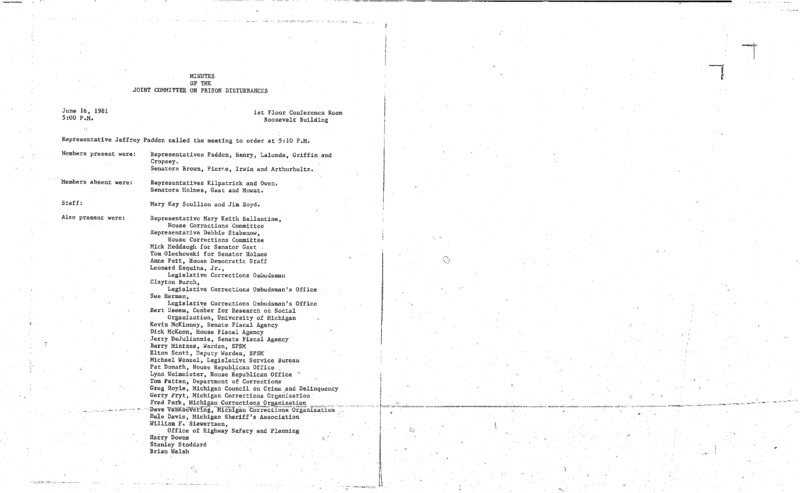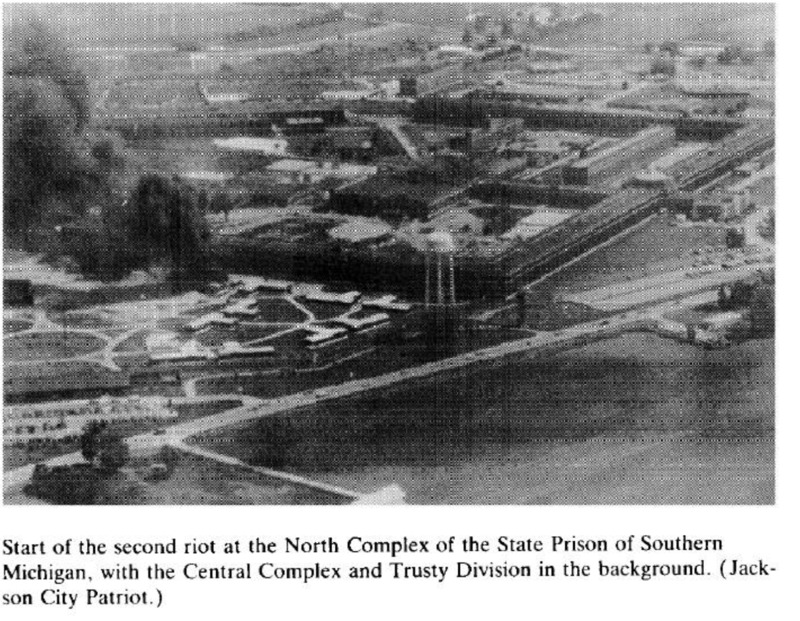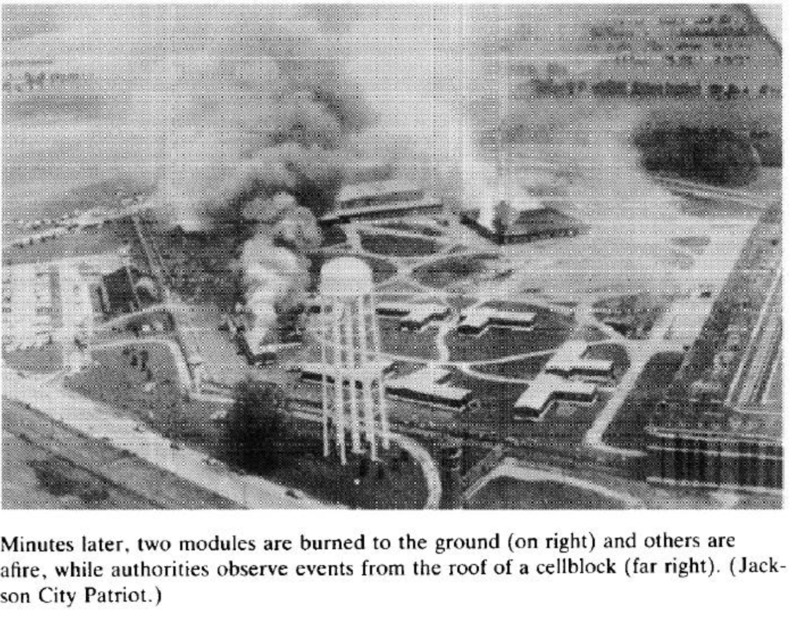Day of Uprising
The first uprising occurred on May 22, 1981. At 9:45 am, the bugle was blown that typically indicates to the 3,000 inmates in Central Complex that the morning recreation time was over. As was typical in 1981, about 200 incarcerated individuals remained on the yard to continue doing their jobs. Fifteen minutes later, at about 10 am, MCO leaders traveled to each Central Complex cell block to tell the corrections officers to not release the incarcerated individuals for their scheduled lunch at 11 am, to lock them down, and to conduct a shakedown and weapons search. It appears that at that point, a sergeant who was more loyal to the administration than to MCO called each of the cell blocks and reversed the previous orders, commanding everyone to carry on with business as usual. At 10:15 am, Warden Barry Mintzes arrived at Jackson Prison and told the MCO officers to halt their planned lockdown. Rumors had started spreading that MCO was going to lockdown incarcerated individuals for the entire Memorial Day holiday weekend, which meant that the extra recreation time, family visits, and free time typically associated with holidays would no longer be happening.
Shortly before noon, at approximately 11:55 am, inmates who were in the yard entered Cell Block 3 and freed other inmates who were housed there, triggering “full emergency” mode to be activated. The start of the uprising is where the story diverges however – what the corrections officers attest and what the incarcerated individuals (backed by state officials) state happened are vastly different. According to corrections officers as part of MCO, a large group of incarcerated individuals (around 80-150) swarmed “defenseless guards” and took their keys by force. This narrative perpetuated their claims that Jackson Prison Management was failing as incarcerated individuals were becoming more violent with an already understaffed population. Incarcerated individuals state that only a few people entered Cell Block 3 and asked why others had not been released for lunch as scheduled. They also expressed frustration with the rumor that they were going to be locked down throughout the weekend while COs went on strike. At this point, a guard handed their keys to the inmates, essentially telling them to do whatever they wanted. State officials often argue that an unauthorized shakedown of incarcerated individuals by already bitter MCO officials (due to overcrowding, understaffing, and recent attacks on guards) was the real reason for the uprising.
Regardless of the reason for the uprising, by about 12:30 pm, after Cell Blocks 3 and 4 had been released, word spread that the inmates planned to move towards blocks 5 and 8. In response, rifle squads had been sent to blocks 5 and 8 beforehand, containing the uprising to the yard and Cell Blocks 3 and 4. At 1:10 pm, a gun squad secured the two housing blocks (after being told to only shoot if attacked), ultimately trapping people in the yard. However, reports state that the yard was peaceful and calm – although there was some looting, most just played cards and ate food. At this time, Deputy Warden Elton Scott offered for people to bring forward grievances, however, allegedly, no one had any to bring forward. The uprising continued like this, with small fires and damage done to the two housing units for the rest of the day.
By 7:45 pm, Deputy Warden Elton Scott ordered unarmed guards to replace the gun squads, and by 8 pm, Warden Mintzes came over the loudspeaker with the following message.
“Attention all inmates, this is Warden Mintzes. We are aware of all that took place today. At this time we are only interested in restoring order. We want to permit you all to return to your housing units so that we can get you fed and start getting operations back to normal. We are not interested in reprisals. We simply want to blow the yard in and gradually begin to restore order. If you will all cooperate, we can accomplish this in an orderly fashion. . . . Let's work together to get order restored and rebuild what has been destroyed.”
For the rest of the weekend, the inmates were locked down in their housing units. While all of these events occurred in the Central Complex of Jackson Prison, a simultaneous uprising was occuring in the North Complex.
In the North complex, modulars had been set on fire, looting occurred, and inmates chanted that the guards had been the ones to start the riots. Unlike the Central Complex, incarcerated individuals in the North Complex asked to meet with Warden Mintzes to display a list of grievances. Their grievances included the poor handling of inmate mail, inhumane medical treatment, the broken grievance process, and proposed “amnesty” for those involved in the uprising since it had been the fault of the guards. Allegedly, Mintzes refused to talk about blanket amnesty, which frustrated some, however he did agree to meet with them in the coming days, according to Deputy Warden Willie Cason. For both complexes, lockdown ended on Monday. And on Tuesday, another uprising started.
In total during that first weekend of uprisings, approximately 1700 inmates took control of at least 2 cell blocks, at least 8 injuries were reported, and a refreshment stand, inmate store, paint shop, and temporary building with a counseling center were destroyed. More than 160 state police officers were mobilized, the National Guard was on alert, and reserve guards from Michigan Reformatory at Ionia were even called to the scene.
On May 27, 1981, a second uprising at Jackson prison began. There were no hostages and no fatalities during this uprising, however 165 state police officers and 200 prison guards were called in to quell the uprising. At about 7 AM on May 27, incarcerated individuals armed themselves with clubs to prevent other inmates on Central Complex from going to work. At 8:30 am, during the exercise period of the day, incarcerated individuals collaborated to discuss what would occur during the uprising. However, not all incarcerated individuals supported this second uprising, notably the small group of individuals who had talked to Warden Mintzes the previous weekend, who did not want to undermine their grievances. Negotiations were scheduled to begin at about 11 am between the Wardens and incarcerated individuals, however the Wardens did not show up. At noon, fires started around the complex. By 12:20 pm, active participants in the uprisings began approaching living modules where they removed the property inside and set them on fire. By 1:30, most of the Northside campus was engulfed in flames. By 3 PM, the fire department had arrived on the scene and gun squads were deployed, including reinforcements from Jackson Police Department, and the Michigan State Police. By 8 pm, plans to retake the prison were created when 100 armed officers entered the complex and ordered the inmates to return to their cells, which they did. This uprising, although shorter than the uprising on May 22, is believed to have sparked uprisings at two other institutions nearby – Marquette and Ionia.



